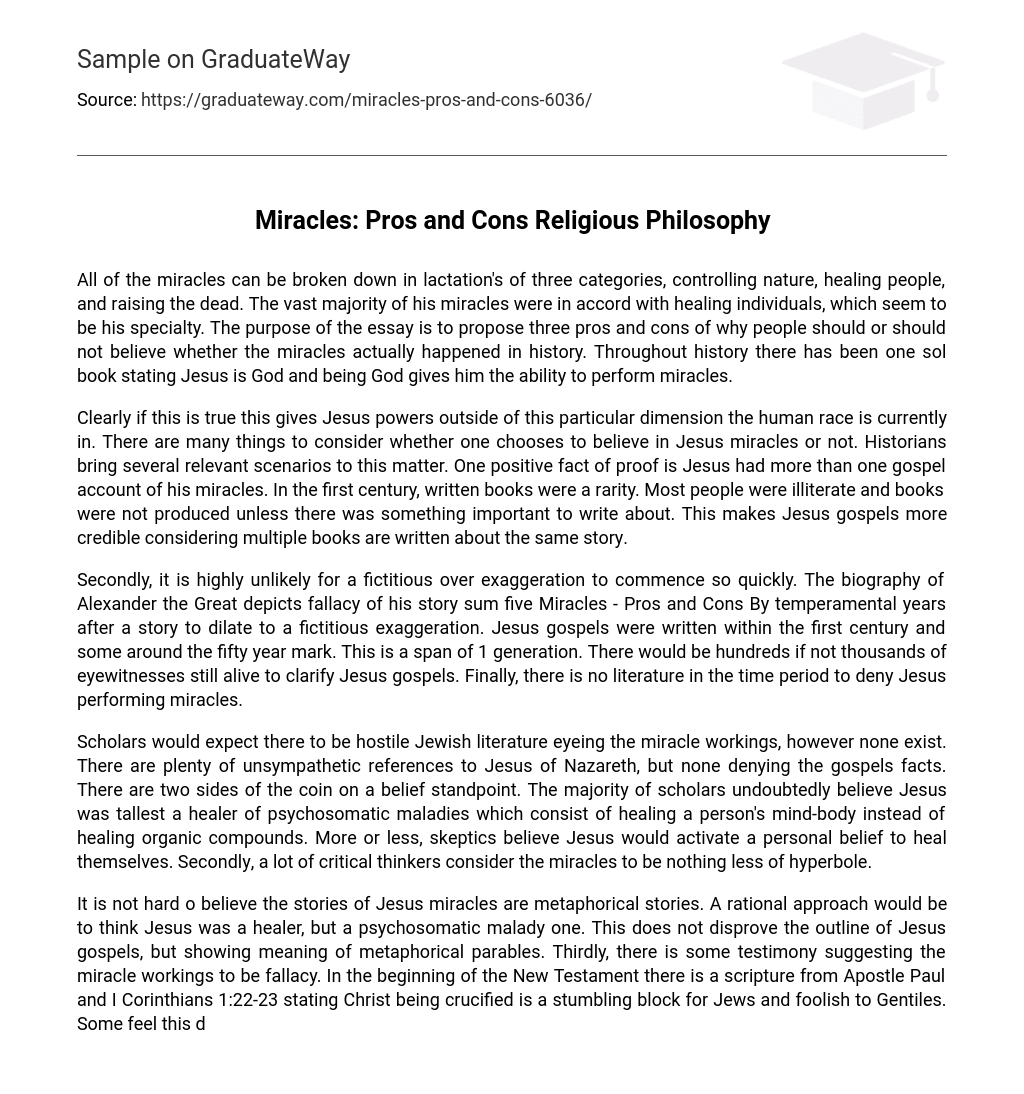All of the miracles can be broken down in lactation’s of three categories, controlling nature, healing people, and raising the dead. The vast majority of his miracles were in accord with healing individuals, which seem to be his specialty. The purpose of the essay is to propose three pros and cons of why people should or should not believe whether the miracles actually happened in history. Throughout history there has been one sol book stating Jesus is God and being God gives him the ability to perform miracles.
Clearly if this is true this gives Jesus powers outside of this particular dimension the human race is currently in. There are many things to consider whether one chooses to believe in Jesus miracles or not. Historians bring several relevant scenarios to this matter. One positive fact of proof is Jesus had more than one gospel account of his miracles. In the first century, written books were a rarity. Most people were illiterate and books were not produced unless there was something important to write about. This makes Jesus gospels more credible considering multiple books are written about the same story.
Secondly, it is highly unlikely for a fictitious over exaggeration to commence so quickly. The biography of Alexander the Great depicts fallacy of his story sum five Miracles – Pros and Cons By temperamental years after a story to dilate to a fictitious exaggeration. Jesus gospels were written within the first century and some around the fifty year mark. This is a span of 1 generation. There would be hundreds if not thousands of eyewitnesses still alive to clarify Jesus gospels. Finally, there is no literature in the time period to deny Jesus performing miracles.
Scholars would expect there to be hostile Jewish literature eyeing the miracle workings, however none exist. There are plenty of unsympathetic references to Jesus of Nazareth, but none denying the gospels facts. There are two sides of the coin on a belief standpoint. The majority of scholars undoubtedly believe Jesus was tallest a healer of psychosomatic maladies which consist of healing a person’s mind-body instead of healing organic compounds. More or less, skeptics believe Jesus would activate a personal belief to heal themselves. Secondly, a lot of critical thinkers consider the miracles to be nothing less of hyperbole.
It is not hard o believe the stories of Jesus miracles are metaphorical stories. A rational approach would be to think Jesus was a healer, but a psychosomatic malady one. This does not disprove the outline of Jesus gospels, but showing meaning of metaphorical parables. Thirdly, there is some testimony suggesting the miracle workings to be fallacy. In the beginning of the New Testament there is a scripture from Apostle Paul and I Corinthians 1:22-23 stating Christ being crucified is a stumbling block for Jews and foolish to Gentiles. Some feel this discredits Jesus miracle workings and even the Tory of Jesus.
There are several cons and pros to proving and disproving Jesus miracles proclaimed in the gospels. In turn, there is no denying the lack of hard scientific evidence to consolidate the miracles as fact or for it being wrong. One can not doubt existence itself or other accounts of dimensional space inhabitance. Quantum mechanics have been proving existence in extra dimensional realms inside of the third dimension and for the authors viewpoint it is not hard to consider the possibilities of producing miracles. Simply not understanding something does not mean it does not exist.





